Rail transport in Nigeria
Railways in Nigeria are operated by the Nigerian Railway Corporation. Nigeria's rail system consists of 3,505 km of 3 ft 6 in (1,067 mm) gauge lines and 507 km of standard gauge lines. Efforts are underway to develop the Cape gauge network as well as construct a new standard gauge network that can help transportation through this means to be suitable.


National network
Cape gauge
The Nigerian railways were originally built by the colonial power, Great Britain. The railways were built to the 3 ft 6 in (1,067 mm) Cape gauge, the same track gauge used in most other British colonies in Africa.
The country has two major Cape-gauge rail lines:
- The Western Line connects Lagos on the Bight of Benin to Nguru in the northern state of Yobe, over a distance of 1,126 kilometers (700 mi).
- The Eastern Line connects Port Harcourt in the Southeast to Maiduguri in the northeastern state of Borno, near the border with Chad.
There are also several branch lines:
- The Linking Line connects Kaduna on the Western Line to Kafanchan on the Eastern Line.
- Ifaw–Ilaro (Western Line), 20 kilometers (12 mi)
- Minna–Baro (Western Line), 150 kilometers (93 mi)
- Zaria–Kaura Namoda (Western Line), 245 kilometers (152 mi).
- Kuru–Jos (Eastern Line), 55 kilometers (34 mi)
- Baro-Kano Railway Station (Northern Line), 200 kilometer (120 mi).
The 2 ft 6 in (762 mm) gauge Bauchi Light Railway operated between Zaria and Bukuru over a distance 143 miles and was opened in stages between 1912 and 1914. In 1927 the ten mile section between Jos and Bukuru was converted to 3 ft 6 in (1,067 mm) becoming part of the Kafanchan to Jos branch line. The 2ft 6in Zaria - Jos section continued to operate until 1957 when it was abandoned.[1]
There was also the short lived 2ft 6in gauge Wushishi Tramway which connected Wushishi with Zungeru (12 miles) in 1901 and which was extended in 1902 from Wushishi to Bari-Juko (10 miles). It closed circa 1911 with its two Hunslet built 0-6-2T locomotives being transferred to the Bauchi Light Railway.[1]
Mention must also be made of the Lagos Steam Tramway (1902)[2][3] and the Lagos Sanitary Tramway (1906), both of 2ft 6in gauge.[1][2]
There are no railway links with adjacent countries. Nigeria does not use the same track gauge as its neighbours, where the French and German colonial government built metre gauge railway networks. There were plans to establish rail links to Niger through Illela in Sokoto state and Cameroon, but these have not yet been built.
Lagos-Kano Standard Gauge Railway
A standard gauge railway connects the national capital of Abuja to the city of Kaduna, an important junction point on the Cape gauge railway network. The 187 km line is the first segment of the planned Lagos–Kano Standard Gauge Railway to be completed.[4] In 2018 the Nigerian government awarded a contract to China Civil Engineering Construction Corporation (CCECC) to complete the remaining portions of the line. In June 2020, Rotimi Amaechi, Nigeria's Minister of Transportation, announced that construction had commenced on the Abuja-Kano segment of the line.[5]
Warri-Ajaokuta-Itakpe Standard Gauge Railway
The Warri–Itakpe standard gauge line connects the port city of Warri to Itakpe. The 320 km line began test runs in November 2018, but the stations will not be completed until the first quarter of 2019.[6] In July 2020, Minister of Transportation Rotimi Amaechi announced that construction was complete, and passenger and freight operations would begin soon.[7]
History
Construction
The construction of railways in Nigeria started from Lagos Colony to Ibadan in March 1896, by the British government.
The Lagos Government Railway began operations in March 1901 and was extended to Minna in 1911, where it met the Baro–Kano Railway Station that was built by the government of Northern Nigeria between 1907 and 1911.[8] The two lines were amalgamated in 1912 into the Government Department of Railways, the predecessor to the Nigerian Railway Corporation. The railway reached its northeastern terminus of Nguru in 1930.[9]
After coal was discovered at Udi, the Eastern Railway was built to Port Harcourt between 1913 and 1916. This railway was extended to Kaduna via Kafanchan in 1927, connecting the Eastern Railway to the Lagos–Kano Railway.[10] The Eastern Railway was extended to its northeastern terminus of Maiduguri between 1958 and 1964.[9]
Decline

Years of neglect of both the rolling stock and the right-of-way have seriously reduced the capacity and utility of the system. Couplings of the ABC kind, vacuum brakes and non-roller bearing plain axles are also obsolete. By early 2013, the only operational segment of Nigeria's rail network was between Lagos and Kano. Passenger trains took 31 hours to complete the journey at an average speed of 45 km/h.[11][12]
Rehabilitation
A project to restore Nigeria's railways has been underway since 2009. The eastern line from Port Harcourt to Maiduguri was restored at a cost of US$427 million by Lingo Nigeria, Eser West Africa, and the China Gezhouba Group.[14]
In order to remedy the poor condition, efficiency, and profitability of the nation's railroads, the government is also seeking to privatize the Nigerian Railway Corporation. Under the privatization plan, the railways will be split into three concessions, each to be awarded for a period of 25–30 years.[15]
In 2019, the Cape gauge railways had only 15 functional locomotives.[16]
Standard gauge network
In 2006, the government contracted with the China Civil Engineering Construction Corporation (CCECC) to build the Lagos–Kano Standard Gauge Railway.[4] It was later decided to complete the project in segments due to a lack of funds.[4] After many delays, the segment from Abuja to Kaduna (187 km) opened officially on 26 July 2016.[17] The Lagos–Ibadan section began construction in March 2017.[4] The third section will link Kano to Port Harcourt and Lagos.[4]
In 1987, a contract was awarded to build the Central Line, a standard gauge railway to connect the iron ore deposits at Itakpe to the Ajaokuta Steel Mill and the Atlantic Ocean port of Warri. The railway was originally planned for completion in five years, but sporadic funding stretched out its construction period over 30 years.[18] In August 2017, the Minister of Transportation announced that the railway would be completed by the China Civil Engineering Construction Corporation and Julius Berger.[19] Trial runs began in November 2018,[6] and the railway is expected to be completed after the end of COVID-19.[20] In October 2019, the government signed a $3.9 billion contract with the China Railway Construction Corporation Limited to extend the railway to the national capital of Abuja.[21]
Metro systems
Several metro systems are active or under construction:
- Abuja Light Rail , opened in late 2017
- Lagos Rail Mass Transit
- Rivers Monorail in Port Harcourt
- Calabar Monorail
- Kaduna State Light rail
Maps
References
- Moore, G.S. (July 1964). "Narrow Gauge in Nigeria: Railways of less than the main-line 3ft 6in gauge, and their locomotives". Railway Magazine. Vol. 110 no. 759. pp. 578–581.
- Miller, Neville S. (1958). The Lagos Steam Tramway 1902-1933. W. I. Fowler & Son Ltd., London.
- Miller, Neville (February 1966). "Nigerian Island Tramway: The erstwhile Lagos Steam Tramway and its unique locomotives". Railway Magazine. Vol. 112 no. 778. pp. 103–106.
- "Getting Nigeria's railways back on track with China's help". BBC News. BBC News. 7 December 2017. Retrieved 7 December 2017.
- Dirisu Yakubu (22 July 2020). "FG kicks-off Lagos-Kano railway project". Vanguard News Nigeria. Vanguard News Nigeria. Retrieved 31 July 2020.
- Ejike, Ejike (26 November 2018). "Itakpe Train Service Begins Operation Today". Leadership.
- "Itakpe/Warri rail line begins operations soon, says Amaechi". The Sun. 20 July 2020. Retrieved 31 July 2020.
- Carland, John (1985). The Colonial Office and Nigeria, 1898-1914. Hoover Press. pp. 135–183. ISBN 9780817981433.
- Yakubu; et al., eds. (2005). Northern Nigeria: A Century of Transformation, 1903-2003. Kaduna, Nigeria: Arewa House, Ahmadu Bello University. p. 352. ISBN 9789781351426.
- Chuku, Gloria (2015). Igbo Women and Economic Transformation in Southeastern Nigeria, 1900-1960. p. 156. ISBN 9781135469405.
- Ross, Will (13 February 2013). "Can Nigeria's renovated railway unite north and south?". BBC.
- "A slow but steady new chug". The Economist. 9 February 2013.
- Komolafe, Oladayo (17 February 2015). "Overseeing the resurrection of Nigerian railways | NAN". News Agency of Nigeria. Archived from the original on 26 July 2016.
- Oirere, Shem (1 October 2014). "Insurgents threaten reopening of Nigerian line". International Railway Journal.
- Smith, Kevin (16 February 2015). "Privatisation bill for Nigerian railways approved".
- Ugbomeh, Fidelis (7 April 2019). "Rail Development Will Boost Economic Growth – Okhiria". Leadership Newspaper.
- "President inaugurates Abuja – Kaduna railway". Railway Gazette.
- Nnabugwu, Favour (15 August 2017). "FG moves to complete N40bn central rail line". Vanguard News.
- "Itakpe-Ajaokuta-Warri rail line to start operation in June 2018 - Rotimi Amaechi". Vanguard News. 7 August 2017.
- "20 new rail coaches'll arrive next month –Amaechi". Punch Newspapers. 22 October 2019.
- Ogunyinka, Victor (11 October 2019). "Nigeria/China deal: FG okays $3.9bn for Abuja-Itakpe rail line". Vanguard News.
External links
![]() Media related to Rail transport in Nigeria at Wikimedia Commons
Media related to Rail transport in Nigeria at Wikimedia Commons